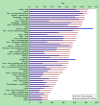Prefrontal cortex eQTLs/mQTLs enriched in genetic variants associated with alcohol use disorder and other diseases
- PMID: 32496132
- PMCID: PMC7607393
- DOI: 10.2217/epi-2019-0270
Prefrontal cortex eQTLs/mQTLs enriched in genetic variants associated with alcohol use disorder and other diseases
Abstract
Aim: This study aimed to investigate the function of genome-wide association study (GWAS)-identified variants associated with alcohol use disorder (AUD)/comorbid psychiatric disorders. Materials & methods: Genome-wide genotype, transcriptome and DNA methylome data were obtained from postmortem prefrontal cortex (PFC) of 48 Caucasians (24 AUD cases/24 controls). Expression/methylation quantitative trait loci (eQTL/mQTL) were identified and their enrichment in GWAS signals for the above disorders were analyzed. Results: PFC cis-eQTLs (923 from cases+controls, 27 from cases and 98 from controls) and cis-mQTLs (9,932 from cases+controls, 264 from cases and 695 from controls) were enriched in GWAS-identified genetic variants for the above disorders. Cis-eQTLs from AUD cases were mapped to morphine addiction-related genes. Conclusion: PFC cis-eQTLs/cis-mQTLs influence gene expression/DNA methylation patterns, thus increasing the disease risk.
Keywords: alcohol use disorder; enrichment analysis; expression quantitative trait loci; genome-wide association study; human prefrontal cortex; methylation quantitative trait loci.
Conflict of interest statement
This work was supported by grants (R01AA025080 [H Zhang] and R21AA023068 [H Zhang]) from the National Institute on Alcohol Abuse and Alcoholism (NIAAA). The authors have no other relevant affiliations or financial involvement with any organization or entity with a financial interest in or financial conflict with the subject matter or materials discussed in the manuscript apart from those disclosed.
No writing assistance was utilized in the production of this manuscript.
Figures
Similar articles
-
Illuminating links between cis-regulators and trans-acting variants in the human prefrontal cortex.Genome Med. 2022 Nov 24;14(1):133. doi: 10.1186/s13073-022-01133-8. Genome Med. 2022. PMID: 36424644 Free PMC article.
-
Enrichment of cis-regulatory gene expression SNPs and methylation quantitative trait loci among bipolar disorder susceptibility variants.Mol Psychiatry. 2013 Mar;18(3):340-6. doi: 10.1038/mp.2011.174. Epub 2012 Jan 3. Mol Psychiatry. 2013. PMID: 22212596 Free PMC article.
-
Identification of methylation quantitative trait loci (mQTLs) influencing promoter DNA methylation of alcohol dependence risk genes.Hum Genet. 2014 Sep;133(9):1093-104. doi: 10.1007/s00439-014-1452-2. Epub 2014 Jun 3. Hum Genet. 2014. PMID: 24889829 Free PMC article.
-
Genetic-epigenetic interactions in cis: a major focus in the post-GWAS era.Genome Biol. 2017 Jun 19;18(1):120. doi: 10.1186/s13059-017-1250-y. Genome Biol. 2017. PMID: 28629478 Free PMC article. Review.
-
Expression Quantitative Trait Loci Information Improves Predictive Modeling of Disease Relevance of Non-Coding Genetic Variation.PLoS One. 2015 Oct 16;10(10):e0140758. doi: 10.1371/journal.pone.0140758. eCollection 2015. PLoS One. 2015. PMID: 26474488 Free PMC article. Review.
Cited by
-
PTGES2 and RNASET2 identified as novel potential biomarkers and therapeutic targets for basal cell carcinoma: insights from proteome-wide mendelian randomization, colocalization, and MR-PheWAS analyses.Front Pharmacol. 2024 Jul 5;15:1418560. doi: 10.3389/fphar.2024.1418560. eCollection 2024. Front Pharmacol. 2024. PMID: 39035989 Free PMC article.
-
Dual methylation and hydroxymethylation study of alcohol use disorder.Addict Biol. 2022 Mar;27(2):e13114. doi: 10.1111/adb.13114. Epub 2021 Nov 17. Addict Biol. 2022. PMID: 34791764 Free PMC article.
-
Role of DNA Methylation in Mediating Genetic Risk of Psychiatric Disorders.Front Psychiatry. 2021 Apr 1;12:596821. doi: 10.3389/fpsyt.2021.596821. eCollection 2021. Front Psychiatry. 2021. PMID: 33868039 Free PMC article. Review.
-
Trans-eQTL hotspots shape complex traits by modulating cellular states.Cell Genom. 2025 May 14;5(5):100873. doi: 10.1016/j.xgen.2025.100873. Epub 2025 May 5. Cell Genom. 2025. PMID: 40328252 Free PMC article.
-
The Genetically Informed Neurobiology of Addiction (GINA) model.Nat Rev Neurosci. 2023 Jan;24(1):40-57. doi: 10.1038/s41583-022-00656-8. Epub 2022 Nov 29. Nat Rev Neurosci. 2023. PMID: 36446900 Free PMC article. Review.
References
-
- Results of the 2015 National Survey on Drug Use and Health (NSDUH): detailed Tables. Center for Behavioral Health Statistics and Quality. Substance Abuse and Mental Health Services Administration, MD, USA: (2016).
Publication types
MeSH terms
Grants and funding
LinkOut - more resources
Full Text Sources
Medical
Molecular Biology Databases
Miscellaneous

